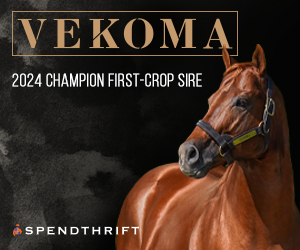
By: Paige Galindo
How did it end up like this? He has been biting and fidgeting while getting tacked up or being groomed. He is exceptionally grumpy when the girth is tightened or when the rider mounts, nipping and even bolting in the process. When he is warming up on the track, he is tossing his head and is a little stiff on one side. In racehorses, it is common for the impingement of the dorsal spinous processes, or kissing spine, to occur. But obviously, it isn’t only a kiss. This is when two or more of the spinous processes either touch or rub against each other, causing large amounts of discomfort for the horse. The discomfort is bothersome enough to affect performance and the horse’s overall attitude, making him bite and even buck more often than what would be considered normal behavior. Spinous process refers to the bone flanges that flare out at the top of each vertebra.
The exact causes of kissing spine remain unclear. Typically, the pain occurs towards the end of the horse’s back, where a rider’s seat and the edge of the saddle sit. Thoroughbreds, Quarter Horses, and Warmbloods are often afflicted with kissing spine and it is widely thought this stems from the disciplines typical for these breeds. While it may seem logical to assume a rider’s weight is the culprit, evidence suggests otherwise. Researchers have studied the skeletons of extinct species of horses and still found kissing spines present in these animals that never even bore a rider. While weight from the rider can reposition the spine and the demands from sports like racing and dressage can lead to spinous processes rubbing together, the fact remains that this ailment still can occur in a riderless horse, making exact causes still a mystery to discover.
Thoroughbreds tend to be more prone to kissing spine because their spinous processes are naturally closer together. Couple that with the intensity of racing and the presence of a rider on their backs, and this is an ideal situation for the gap to close even more between the processes. Normally, treatment for this problem can include shock wave therapy, corticosteroid injections along the spine, and exercise programs to alleviate pressure off the overriding spinous processes. However, in an attempt to provide an effective treatment that gets horses back on the track sooner and without relapse, a fairly new treatment was introduced and studied in a number of racehorses with kissing spines.
Between February 2015 and September 2016, 236 racehorses were part of a test to perform a desmotomy on the overlapping spinous processes and 159 met the criteria for a successful procedure. The results showed significant improvement than the normal results for past procedures. Within four weeks, the racehorses were not only able to return to the track but they also displayed long-term improvement in their performance. But what made the difference? The desmotomy was able to address the back pain and the rubbing bones all at once.
Many times when discussing a desmotomy, it’s important to make the distinction between a desmotomy and a tenotomy because both are similar in nature. A tenotomy directly severs, or separates, a tendon such as the severing of the deep digital flexor tendon in the case of laminitis to halt the coffin bone’s rotation. A desmotomy simply cuts a ligament and is therefore less invasive allowing for a faster recovery.
Traditional surgical procedures for kissing spine have long recovery periods and oftentimes the horses are left with decreased levels of performance. The recovery period for these surgeries tend to last for approximately five months. Other treatments, such as corticosteroid injections, merely take away the horses’ pain but never address the problem of the overlapping bones. This leaves the horse with only masked pain that will return in full force once the injections wear off and a vicious cycle ensues without a real long-term solution.In the case of treating kissing spine, a desmotomy targets the interspinous ligaments between the spinous processes.
When the studied racehorses were treated with a desmotomy, the vet simply sedated the horses but was able to leave them in a standing position. The recovery period was approximately four weeks before the horses were permitted to being under a saddle again. Cutting the ligament in this manner not only alleviates the pressure from the touching bones but it also encourages natural spinal remobilization within a shorter time frame, killing two birds with one stone. Or, more specifically, a scalpel.
Always check with Past the Wire for the latest horse racing news and more…..



